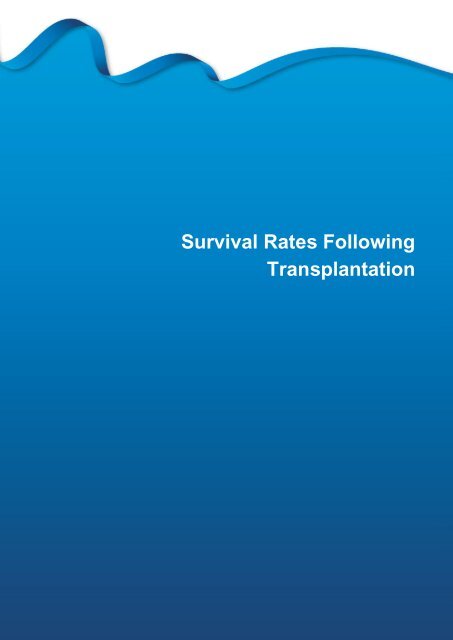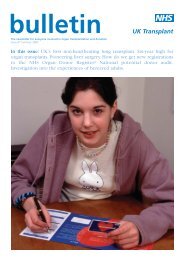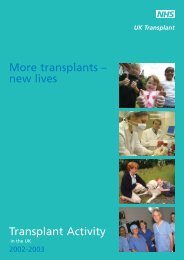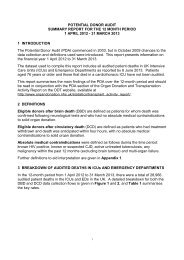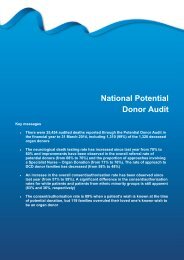Section 11 - Survival rates following transplantation - Organ Donation
Section 11 - Survival rates following transplantation - Organ Donation
Section 11 - Survival rates following transplantation - Organ Donation
You also want an ePaper? Increase the reach of your titles
YUMPU automatically turns print PDFs into web optimized ePapers that Google loves.
<strong>11</strong> <strong>Survival</strong> Rates Following Transplantation<br />
<strong>Survival</strong> Rates Following<br />
Transplantation<br />
- 95 -
This chapter shows graft survival <strong>rates</strong> over time for kidney, pancreas and cornea transplants, and<br />
patient survival estimates for kidney, pancreas, cardiothoracic, liver and intestinal transplants,<br />
performed in the UK. Separate estimates are presented for adult and paediatric patients (using<br />
organ specific age definitions) and for transplants from donors after brain death and donors after<br />
circulatory death.<br />
In all cases, the Kaplan-Meier estimate of the survivor function was used to provide the survival rate<br />
and groups (years) were compared using the log-rank test. The analyses do not take account of risk<br />
factors which may change over time. Graft survival is defined as time from transplant to graft failure,<br />
censoring for death with a functioning graft and grafts still functioning at time of analysis. Patient<br />
survival is defined as time from transplant to patient death, censoring for patients still alive at time of<br />
analysis. Both analyses consider only first transplants.<br />
- 96 -
% Graft survival<br />
<strong>11</strong>.1 Kidney graft and patient survival<br />
<strong>11</strong>.1.1 Adult kidney recipients - donor after brain death (DBD)<br />
Figure <strong>11</strong>.1 shows long-term graft survival in adult (≥18 years) recipients for first kidney only transplant from donors after brain death. Table <strong>11</strong>.1<br />
shows the graft survival estimates and confidence intervals for one, two, five and ten years post-transplant. There have been significant<br />
improvements in one and two year survival over the time periods shown, p
% Graft survival<br />
<strong>11</strong>.1.2 Adult kidney recipients - donor after circulatory death (DCD)<br />
Long-term graft survival in adult recipients for kidney transplants from donors after circulatory death is shown in Figure <strong>11</strong>.2. Table <strong>11</strong>.3 shows the<br />
graft survival estimates and confidence intervals for one, two, five and ten years post-transplant. There has been a significant improvement in one,<br />
two and five year survival over the time periods shown, p
% Graft survival<br />
<strong>11</strong>.1.3 Adult kidney recipients - living donor<br />
Long-term graft survival in adult recipients for living donor kidney transplants in the UK is shown in Figure <strong>11</strong>.3. Table <strong>11</strong>.5 shows graft survival<br />
estimates and confidence intervals for each time period analysed. There has been a significant improvement in one, two and five year survival over<br />
the time periods shown, p0.2).<br />
Figure <strong>11</strong>.3<br />
Long-term graft survival after first adult living donor<br />
kidney only transplant in the UK,<br />
1 January 2000 – 31 December 2012<br />
Table <strong>11</strong>.5<br />
Graft survival after first adult living donor kidney transplant<br />
Year of No. at risk % Graft survival (95% confidence interval)<br />
transplant on day 0 One year Two year Five year Ten year<br />
2000-2002 831 94 (92-95) 93 (91-94) 88 (85-90) 77 (74-80)<br />
2003-2005 <strong>11</strong>41 96 (95-97) 95 (94-96) 91 (90-93)<br />
2006-2008 1879 96 (96-97) 95 (94-96) 91 (90-93)<br />
2009-2012 2998 97 (96-98)<br />
Table <strong>11</strong>.6<br />
Patient survival after first adult living donor kidney transplant<br />
Year of No. at risk % Patient survival (95% confidence interval)<br />
transplant on day 0 One year Two year Five year Ten year<br />
Year of transplant<br />
(Number at risk on day 0)<br />
2000-2002 831 98 (97-99) 97 (96-98) 95 (93-96) 89 (87-91)<br />
2003-2005 <strong>11</strong>40 99 (98-99) 98 (97-99) 96 (95-97)<br />
2006-2008 1879 99 (98-99) 98 (97-99) 95 (94-96)<br />
2009-2012 2997 99 (98-99)<br />
Years since transplant<br />
- 99 -
% Graft survival<br />
<strong>11</strong>.1.4 Paediatric kidney recipients - donor after brain death (DBD)<br />
Figure <strong>11</strong>.4 shows long-term graft survival in paediatric (
% Graft survival<br />
<strong>11</strong>.1.5 Paediatric kidney recipients - living donor<br />
Long-term graft survival in paediatric recipients for living donor kidney transplants in the UK is shown in Figure <strong>11</strong>.5. Table <strong>11</strong>.9 shows graft<br />
survival estimates and confidence intervals for each time period analysed. There has been a significant improvement in five year survival over the<br />
time period, p0.3). There were insufficient paediatric recipients of first kidney<br />
only transplants from donors after circulatory death to permit reliable analysis.<br />
Figure <strong>11</strong>.5<br />
Long-term graft survival after first paediatric living<br />
donor kidney only transplant in the UK,<br />
1 January 2000 – 31 December 2012<br />
Table <strong>11</strong>.9<br />
Graft survival after first paediatric living donor kidney transplant<br />
Year of No. at risk % Graft survival (95% confidence interval)<br />
transplant on day 0 One year Two year Five year Ten year<br />
2000-2002 100 94 (87-97) 91 (83-95) 84 (75-90) 72 (62-80)<br />
2003-2005 121 97 (91-99) 97 (91-99) 94 (87-97)<br />
2006-2008 157 97 (93-99) 97 (93-99) 93 (88-96)<br />
2009-2012 244 95 (91-97)<br />
Table <strong>11</strong>.10<br />
Patient survival after first paediatric living donor kidney transplant<br />
Year of transplant<br />
(Number at risk on day 0)<br />
Years since transplant<br />
Year of No. at risk % Patient survival (95% confidence interval)<br />
transplant on day 0 One year Two year Five year Ten year<br />
2000-2002 101 97 (91-99) 97 (91-99) 96 (89-98) 92 (85-96)<br />
2003-2005 121 98 (93-100) 98 (93-100) 98 (93-100)<br />
2006-2008 157 99 (96-100) 99 (96-100) 99 (95-100)<br />
2009-2012 244 99 (97-100)<br />
- 101 -
% Graft survival<br />
<strong>11</strong>.2 Pancreas graft and patient survival<br />
<strong>11</strong>.2.1 Simultaneous kidney/pancreas transplants - donor after brain death (DBD)<br />
National pancreas follow-up data are only available for transplants performed since 1 January 2001. There are insufficient data available to analyse<br />
long-term survival. Figure <strong>11</strong>.6 shows pancreas graft survival in recipients receiving their first simultaneous kidney/pancreas (SPK) transplant<br />
performed from donors after brain death, 2003 – 2005, 2006 - 2008 and 2009 - 2012. Graft and patient survival estimates and confidence intervals<br />
are shown at one year, two years and five years in Table <strong>11</strong>.<strong>11</strong> and Table <strong>11</strong>.12 respectively. Results relate to adults only as there are no<br />
paediatric pancreas transplant recipients.<br />
Figure <strong>11</strong>.6<br />
Pancreas graft survival after first SPK transplant<br />
from donors after brain death,<br />
1 January 2003 – 31 December 2012<br />
Table <strong>11</strong>.<strong>11</strong><br />
Graft survival after first SPK transplant from a DBD<br />
Year of No. at risk % Graft survival (95% confidence interval)<br />
transplant on day 0 One year Two year Five year<br />
2003-2005 203 82 (75-86) 77 (71-83) 71 (64-77)<br />
2006-2008 429 88 (84-90) 85 (81-88) 76 (72-80)<br />
2009-2012 496 84 (80-87)<br />
Table <strong>11</strong>.12<br />
Patient survival after first SPK transplant from a DBD<br />
Year of No. at risk % Patient survival (95% confidence interval)<br />
transplant on day 0 One year Two year Five year<br />
Year of transplant<br />
(Number at risk on day 0)<br />
2003-2005 204 94 (89-96) 92 (87-95) 86 (80-90)<br />
2006-2008 430 96 (93-97) 94 (91-96) 90 (87-93)<br />
2009-2012 497 96 (94-98)<br />
Years since transplant<br />
- 102 -
% Graft survival<br />
<strong>11</strong>.2.2 Simultaneous kidney/pancreas transplants - donor after circulatory death (DCD)<br />
The majority of simultaneous kidney/pancreas (SPK) transplants from a DCD have been performed since 1 January 2007, so there are insufficient<br />
data available to analyse long-term survival. Figure <strong>11</strong>.7 shows pancreas graft survival in recipients receiving their first SPK transplant performed<br />
from donors after circulatory death, 2009 - 2012. Graft and patient survival estimates and confidence intervals are shown at one year in Table<br />
<strong>11</strong>.13 and Table <strong>11</strong>.14 respectively. Results are for adult patients only.<br />
Figure <strong>11</strong>.7<br />
Pancreas graft survival after first SPK transplant<br />
from donors after circulatory death,<br />
1 January 2009 – 31 December 2012<br />
Table <strong>11</strong>.13<br />
Graft survival after first SPK transplant from a DCD<br />
Year of No. at risk % Patient survival (95% confidence interval)<br />
transplant on day 0 One year<br />
2009-2012 107 91 (83-95)<br />
Table <strong>11</strong>.14<br />
Patient survival after first SPK transplant from a DCD<br />
Year of No. at risk % Patient survival (95% confidence interval)<br />
transplant on day 0 One year<br />
2009-2012 107 98 (93-100)<br />
Year of transplant<br />
(Number at risk on day 0)<br />
2009-2012 (107)<br />
Years since transplant<br />
- 103 -
% Graft survival<br />
<strong>11</strong>.2.3 Pancreas only transplants - donor after brain death (DBD)<br />
Figure <strong>11</strong>.8 shows pancreas graft survival in recipients receiving their first pancreas only transplant performed from donors after brain death, 2003 -<br />
2005, 2006 - 2008 and 2009 - 2012. Graft and patient survival estimates and confidence intervals are shown at one year, two years and five years<br />
in Table <strong>11</strong>.15 and Table <strong>11</strong>.16 respectively. Results are for adult patients only.<br />
Figure <strong>11</strong>.8<br />
Pancreas graft survival after pancreas only transplant<br />
from donors after brain death,<br />
1 January 2003 – 31 December 2012<br />
Table <strong>11</strong>.15<br />
Graft survival after first pancreas only transplant from a DBD<br />
Year of No. at risk % Graft survival (95% confidence interval)<br />
transplant on day 0 One year Two year Five year<br />
2003-2005 30 70 (50-83) 57 (37-72) 50 (31-66)<br />
2006-2008 71 69 (56-78) 57 (45-68) 44 (32-55)<br />
2009-2012 83 66 (55-75)<br />
Table <strong>11</strong>.16<br />
Patient survival after first pancreas only transplant from a DBD<br />
Year of No. at risk % Patient survival (95% confidence interval)<br />
transplant on day 0 One year Two year Five year<br />
Year of transplant<br />
(Number at risk on day 0)<br />
2003-2005 31 100 (-) 100 (-) 92 (72-98)<br />
2006-2008 71 94 (85-98) 91 (81-96) 85 (73-92)<br />
2009-2012 84 97 (88-99)<br />
Years since transplant<br />
- 104 -
% Graft survival<br />
<strong>11</strong>.2.4 Pancreas only transplants - donor after circulatory death (DCD)<br />
Figure <strong>11</strong>.9 shows pancreas graft survival in recipients receiving their first pancreas only transplant performed from donors after brain death, 2009 -<br />
2012. Graft and patient survival estimates and confidence intervals are shown at one year in Table <strong>11</strong>.17 and Table <strong>11</strong>.18 respectively. Results<br />
are for adult patients only.<br />
Figure <strong>11</strong>.9<br />
Pancreas graft survival after pancreas only transplant<br />
from donors after circulatory death,<br />
1 January 2009 – 31 December 2012<br />
Table <strong>11</strong>.17<br />
Graft survival after first pancreas only transplant from a DCD<br />
Year of No. at risk % Patient survival (95% confidence interval)<br />
transplant on day 0 One year<br />
2009-2012 31 68 (48-81)<br />
Table <strong>11</strong>.18<br />
Patient survival after first pancreas only transplant from a DCD<br />
Year of No. at risk % Patient survival (95% confidence interval)<br />
transplant on day 0 One year<br />
2009-2012 31 97 (78-100)<br />
Year of transplant<br />
(Number at risk on day 0)<br />
2009-2012 (31)<br />
Years since transplant<br />
- 105 -
% Patient survival<br />
<strong>11</strong>.3 Cardiothoracic patient survival<br />
<strong>11</strong>.3.1 Adult heart recipients<br />
Long-term patient survival for adult (>=16 years) recipients after first heart only transplants is shown in Figure <strong>11</strong>.10. Domino and deceased donor<br />
(DBD only) transplants are included as well as urgent patients. Table <strong>11</strong>.19 shows the patient survival estimates and confidence intervals for one,<br />
two, five and ten years post-transplant. There has been a significant improvement in five year survival <strong>rates</strong> over the time period (p
% Patient survival<br />
<strong>11</strong>.3.2 Adult heart/lung block recipients<br />
Patient survival for adult recipients after first heart/lung block transplants is shown in Figure <strong>11</strong>.<strong>11</strong>. Patient survival estimates and confidence<br />
intervals for each time period analysed are shown in Table <strong>11</strong>.20. There were no statistically significant differences in patient survival over time<br />
(p>0.09).<br />
Figure <strong>11</strong>.<strong>11</strong><br />
Long-term patient survival after first adult heart/lung<br />
block transplant in the UK,<br />
1 January 2000 – 31 December 2012<br />
Table <strong>11</strong>.20<br />
Patient survival after first adult heart/lung block transplant<br />
Year of No. at risk % Patient survival (95% confidence interval)<br />
transplant on day 0 One year Two year Five year Ten year<br />
2000-2002 73 66 (54-75) 63 (51-73) 47 (35-57) 36 (25-46)<br />
2003-2005 29 66 (45-80) 66 (45-80) 66 (45-80)<br />
2006-2008 14 86 (54-96) 79 (47-93) 79 (47-93)<br />
2009-2012 13 85 (51-96)<br />
Year of transplant<br />
(Number at risk on day 0)<br />
Years since transplant<br />
- 107 -
% Patient survival<br />
<strong>11</strong>.3.3 Adult lung recipients - donors after brain death (DBD)<br />
Patient survival for adult recipients after first lung only transplant from donors after brain death is shown in Figure <strong>11</strong>.12, with survival estimates and<br />
confidence intervals shown in Table <strong>11</strong>.21. There is significant evidence of improvement in one year patient survival over the period analysed,<br />
p=0.008. There were no statistically significant differences in two or five year patient survival over time (p>0.3).<br />
Figure <strong>11</strong>.12<br />
Long-term patient survival after first adult lung only<br />
transplant from donors after brain death,<br />
1 January 2000 – 31 December 2012<br />
Table <strong>11</strong>.21<br />
Patient survival after first adult lung only transplant from a DBD<br />
Year of No. at risk % Patient survival (95% confidence interval)<br />
transplant on day 0 One year Two year Five year Ten year<br />
2000-2002 283 81 (75-85) 70 (65-75) 54 (48-59) 32 (26-37)<br />
2003-2005 363 73 (68-78) 67 (62-72) 52 (47-57)<br />
2006-2008 334 81 (76-85) 70 (65-75) 55 (50-61)<br />
2009-2012 550 82 (78-85)<br />
Year of transplant<br />
(Number at risk on day 0)<br />
Years since transplant<br />
- 108 -
% Patient survival<br />
<strong>11</strong>.3.4 Adult lung recipients - donors after circulatory death (DCD)<br />
The majority of lung transplants from a DCD have been performed since 1 January 2007, so there is insufficient data available to analyse long-term<br />
patient survival. Patient survival for adult recipients after first lung only transplant from donors after circulatory death is shown in Figure <strong>11</strong>.13, with<br />
survival estimates and confidence intervals shown in Table <strong>11</strong>.22.<br />
Figure <strong>11</strong>.13<br />
Patient survival after first adult lung only transplant<br />
from donors after circulatory death,<br />
1 January 2009 – 31 December 2012<br />
Table <strong>11</strong>.22<br />
Patient survival after first adult lung only transplant from a DCD<br />
Year of No. at risk % Patient survival (95% confidence interval)<br />
transplant on day 0 One year<br />
2009-2012 84 81 (70-88)<br />
Year of transplant<br />
(Number at risk on day 0)<br />
2009-2012 (84)<br />
Years since transplant<br />
- 109 -
% Patient survival<br />
<strong>11</strong>.3.5 Paediatric heart recipients<br />
Long-term patient survival for paediatric recipients after first heart only transplant is shown in Figure <strong>11</strong>.14. Domino and deceased donor<br />
transplants (DBD donors only) are included as well as transplants for urgent patients. Table <strong>11</strong>.23 shows the patient survival estimates and<br />
confidence intervals for one, two, five and ten years post-transplant. There is no evidence of an improvement in one, two or five year survival over<br />
the time period analysed, p>0.06. The number of paediatric lung and heart/lung transplant recipients was too small for analysis.<br />
Figure <strong>11</strong>.14<br />
Long-term patient survival after first paediatric heart<br />
only transplant in the UK,<br />
1 January 2000 – 31 December 2012<br />
Table <strong>11</strong>.23<br />
Patient survival after first paediatric heart only transplant<br />
Year of No. at risk % Patient survival (95% confidence interval)<br />
transplant on day 0 One year Two year Five year Ten year<br />
2000-2002 77 92 (83-96) 88 (78-94) 84 (73-91) 73 (61-81)<br />
2003-2005 76 93 (85-97) 93 (85-97) 85 (75-92)<br />
2006-2008 83 99 (92-100) 98 (91-99) 93 (85-97)<br />
2009-2012 131 89 (83-94)<br />
Year of transplant<br />
(Number at risk on day 0)<br />
Years since transplant<br />
- <strong>11</strong>0 -
% Patient survival<br />
<strong>11</strong>.4 Liver patient survival<br />
<strong>11</strong>.4.1 Adult recipients - donor after brain death (DBD)<br />
Long-term patient survival for adult (>=17 years) recipients after first elective liver only transplants from donors after brain death is shown in Figure<br />
<strong>11</strong>.15. Table <strong>11</strong>.24 shows patient survival estimates at one, two, five and ten years post-transplant. There have been significant improvements in<br />
one and five year patient survival over the time periods analysed, p
% Patient survival<br />
<strong>11</strong>.4.2 Adult recipients - donor after circulatory death (DCD)<br />
Patient survival for adult (>=17 years) recipients after first elective liver only transplants from donors after circulatory death is shown in Figure<br />
<strong>11</strong>.16. Between 1 January 2002 and 31 December 2005 there were only 34 of these liver transplants, so it is not possible to estimate long term<br />
patient survival. Table <strong>11</strong>.25 shows patient survival estimates at one, two and three years post transplant.<br />
Figure <strong>11</strong>.16<br />
Liver patient survival after first elective adult liver<br />
only transplant from donors after circulatory death,<br />
1 January 2006 – 31 December 2012<br />
Table <strong>11</strong>.25<br />
Patient survival after first elective adult liver only transplant from a DCD<br />
Year of No. at risk % Patient survival (95% confidence interval)<br />
transplant on day 0 One year Two year Three year<br />
2006-2008 149 91 (85-94) 85 (78-90) 82 (74-87)<br />
2009-2012 428 88 (85-91)<br />
Year of transplant<br />
(Number at risk on day 0)<br />
2006-2008 (149)<br />
2009-2012 (428)<br />
Years since transplant<br />
- <strong>11</strong>2 -
% Patient survival<br />
<strong>11</strong>.4.3 Paediatric recipients - donor after brain death (DBD)<br />
Figure <strong>11</strong>.17 and Table <strong>11</strong>.26 show long-term patient survival estimates for first elective liver only transplants from donors after brain death in<br />
paediatric (0.5). The number of paediatric transplants from donors after circulatory death was too small to estimate meaningful patient<br />
survival.<br />
Figure <strong>11</strong>.17<br />
Long-term patient survival after first elective<br />
paediatric liver only transplant from donors after<br />
brain death, 1 January 2000 – 31 December 2012<br />
Table <strong>11</strong>.26<br />
Patient survival after first elective paediatric liver only transplant<br />
from a DBD<br />
Year of No. at risk % Patient survival (95% confidence interval)<br />
transplant on day 0 One year Two year Five year Ten year<br />
2000-2002 150 95 (90-97) 94 (89-97) 92 (86-95) 89 (83-93)<br />
2003-2005 143 96 (91-98) 94 (88-97) 91 (85-95)<br />
2006-2008 148 93 (88-96) 91 (85-95) 88 (82-93)<br />
2009-2012 192 95 (91-98)<br />
Year of transplant<br />
(Number at risk on day 0)<br />
Years since transplant<br />
- <strong>11</strong>3 -
% Patient survival<br />
<strong>11</strong>.5 Intestinal patient survival<br />
The majority of intestinal transplants have been performed since 1 January 2006, so there are insufficient data available to analyse long-term<br />
patient survival. Figure <strong>11</strong>.18 and Table <strong>11</strong>.27 show one-year patient survival estimates for recipients receiving their first intestinal transplant, 2008<br />
– 2012, by recipient age group (adults aged ≥ 18 years).<br />
Figure <strong>11</strong>.18<br />
Patient survival after first intestinal graft in the UK,<br />
1 January 2008 – 31 December 2012<br />
Table <strong>11</strong>.27<br />
Patient survival after first intestinal transplant in the UK,<br />
1 January 2008 - 31 December 2012<br />
Recipient No. at risk % Patient survival (95% confidence interval)<br />
age group on day 0 One year<br />
Adult 40 80 (64-89)<br />
Paediatric 25 75 (53-88)<br />
Recipient age group<br />
(Number at risk on day 0)<br />
Years since transplant<br />
- <strong>11</strong>4 -
<strong>11</strong>.6 Cornea graft survival<br />
Good quality cornea follow-up data were only available for transplants performed since 1 April 1999. There are insufficient data available to analyse<br />
long-term survival effects. Figure <strong>11</strong>.19 shows graft survival estimates for first penetrating keratoplasty (PK) for grafts 2003 - 2005, 2006 - 2008<br />
and 2009 - 2012. Graft survival estimates and confidence intervals are shown by transplant year at one, two and five years in Table <strong>11</strong>.28.<br />
Table <strong>11</strong>.28<br />
Cornea graft survival after first PK in the UK<br />
Year of No. at risk % Graft survival (95% confidence interval)<br />
transplant on day 0 One year Two year Five year<br />
2003-2005 3789 94 (93-94) 87 (86-88) 74 (72-76)<br />
2006-2008 2874 93 (92-94) 86 (85-88) 72 (70-74)<br />
2009-2012 2853 91 (90-92)<br />
- <strong>11</strong>5 -


